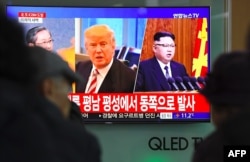North Korea earlier this week launched a new intercontinental ballistic missile – the Hwasong-15 – that reached an altitude of about 4,500 kilometers and traveled about 1,000 kilometers. Pyongyang claims the missile could reach any target in the continental United States.
What is this thing?
On November 28, at 1:17 p.m. EST, the U.S. tracked what it said was the launch of a North Korean intercontinental ballistic missile (ICBM).
According to the Pentagon, the missile “was launched from Sain Ni, North Korea, and traveled about 1,000 kilometers before splashing down in the Sea of Japan, within Japan's Economic Exclusion Zone.”
U.S. officials determined that the launch itself did not pose a threat to North America, U.S. territories or U.S. allies.
North Korea’s state-run media said Wednesday the missile was a Hwasong-15, a new missile “tipped with a super-large heavy warhead which is capable of striking the whole mainland of the U.S."
North Korean leader Kim Jong Un declared the launch a success, boasting the regime has "finally realized the great historic cause of completing the state nuclear force."
What do we know it can do?
North Korea’s state-run television station further said the Hwasong-15 flew 950 kilometers (590 miles) for 53 minutes and reached an altitude of 4,475 kilometers (2,781 miles).
South Korean President Moon Jae-in on Thursday called the missile the most advanced in North Korea’s arsenal.
“It went higher, frankly, than any previous shot they’ve taken, a research and development effort on their part to continue building ballistic missiles that can threaten everywhere in the world, basically," U.S. Defense Secretary Jim Mattis said following a meeting at the White House on Tuesday (November 28).
A U.S. intelligence official confirmed to VOA that the missile’s flight time was the longest to date of any of North Korea’s previous launches.
Based on the available data, “this missile would have a range of more than 13,000 kilometers (8,100 miles),” according to a post by David Wright, co-director of the Union of Concerned Scientists.
“Such a missile would have more than enough range to reach Washington, D.C., and in fact any part of the continental United States,” Wright stated.
What do we not know?
Analysts like Wright say it is not yet clear what type of payload the new North Korean missile carried during this latest test, but they believe it is likely the missile carried only a mock warhead.
“If true, that means it would be incapable of carrying a nuclear warhead to this long distance, since such a warhead would be much heavier,” according to Wright.
South Korean President Moon Jae-in on Thursday said the missile was the most advanced in North Korea’s arsenal but questioned whether Pyongyang has managed to perfect its missile technology.
During a phone call with U.S. President Donald Trump, Moon also said it was not clear whether North Korea’s capabilities had advanced to a point where it would be able to miniaturize a nuclear warhead to mount on a missile.
Are there effective defenses?
The U.S. has a number of defenses in place, including the anti-missile defense system THAAD, which shoots down short-, medium- and intermediate-range ballistic missiles, and the ship-based Aegis system, which can track 100 missiles simultaneously and intercept them. It also has the Patriot missile defense system in Japan.
U.S. Defense Secretary Jim Mattis has said, "Any threat to the United States or its territories, including Guam or our allies, will be met with a massive military response, a response both effective and overwhelming."
The U.S. Missile Defense Agency said the Aegis system successfully intercepted a medium-range ballistic missile during a test in late August off the coast of Hawaii.
The THAAD system also managed to successfully intercept a medium-range ballistic missile during a test in July.
Neither of those tests, though, measured the defense systems’ effectiveness against an ICBM like the Hwasong-15.
The U.S. and South Korea also have proposed spending billions of dollars on additional missile defense systems and installations.
Significance of mobile launcher?
North Korea says it launched the Hwasong-15 from a mobile launcher. The ability to launch a missile from a launch pad that can be moved to different locations makes it more difficult for the United States and its allies to locate the launch site and neutralize the threat.
North Korea’s state-run media also claimed the mobile launcher was made entirely in North Korea.
Not all analysts are convinced the claim is true. But if it is, it means North Korea is no longer reliant on other mobile launchers made by countries such as China, and that the production of additional mobile missile launchers may not be hampered as much by sanctions.
Is this surprising?
Immediately following the November 28 launch, an intelligence official told VOA the United States was "not surprised.”
In fact, top intelligence officials have been warning for months about Pyongyang’s advancing missile and nuclear weapons programs.
Just this past October, two top U.S. officials warned that North Korea was likely just months away from being capable of striking the United States with a nuclear missile.
"We ought to behave as if we are on the cusp of them achieving that objective," CIA Director Mike Pompeo said when asked about Pyongyang's pursuit of missile technology that could launch a warhead to targets in the U.S.
"They are so far along in that it's now a matter of thinking about how do you stop the final step?" he added.
U.S. National Security Advisor H.R. McMaster, speaking at the same forum in Washington, also offered a grim assessment.
"We're not out of time but we're running out of time," McMaster said. "Accept and deter is unacceptable."
What comes next?
North Korea’s latest test has been roundly criticized by world leaders, with many calling for new sanctions or stricter enforcement of existing sanctions against North Korea.
The U.S. also has remained steadfast in its call for Pyongyang to give up its nuclear arsenal.
"This administration is focused on one big thing when it comes to North Korea, and that's denuclearization of the Korean peninsula,” White House press secretary Sarah Huckabee Sanders said Thursday. “That's our number one priority."
But top U.S. intelligence officials think it is unlikely Kim Jong Un would voluntarily give up his nuclear capabilities, seeing it as an indispensable tool.
"Kim Jong Un is a very rational actor," Yong Suk Lee, the deputy assistant director of the Central Intelligence Agency's Korea Mission Center, said at an intelligence conference in October.
"Kim Jong Un wants what all authoritarian rulers want ... to rule for a long time and die peacefully in his own bed," Lee said. "He wants to keep us out of his sandbox."
Material from Reuters and The Associated Press was used in this report.












